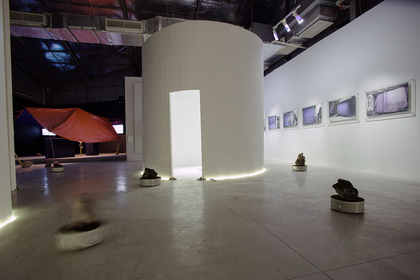-
From Current Issue
-
- Editor’s Letter Fire in the Heart
- Reviews I Gusti Ayu Kadek Murniasih
- Reviews 11th Seoul Mediacity Biennale: “One Escape at a Time”
- Dispatch Networked China
- One on One Monira Al Qadiri on Yukio Mishima
- Essays The rise of independent art spaces in pandemic-era Shanghai
- Features Tuan Andrew Nguyen
- Table of Contents
- Web Exclusives
- Archive
- Subscribe

R
E
V N
E
X
T
Installation view of “In One’s Breath–Nothing Stands Still” at The Factory Contemporary Arts Centre, Ho Chi Minh City, 2018. All photographs by Phan Ngọc Thọ. All images courtesy the artist and the Factory Contemporary Arts Centre, Ho Chi Minh City.
For his solo exhibition at Ho Chi Minh City’s Factory Contemporary Arts Centre, Hanoi-based artist Tuấn Mami has assembled a diverse collection of work related to limestone mining in his hometown of Hà Nam, in Northern Vietnam. Curated by Factory assistant curator Bill Nguyễn, the show features video, sculpture and mixed-media installations (all made between 2014 and 2018), filling The Factory’s cavernous space, and even managing to make it feel a bit claustrophobic. Drawing inspiration from “The Birth of Soil and Water”—an epic poem of the Mường minority people who live around Hà Nam—the artist explores the ancient literary work’s animist themes in the context of contemporary environmental degradation and resource exploitation.
Installation view of TUẤN MAMI’s In One’s Breath, 2014– , six-channel HD video with color and sound: 3 minutes, at “In One’s Breath–Nothing Stands Still,” The Factory Contemporary Arts Centre, Ho Chi Minh City, 2018.
Viewers enter the exhibition by stepping into a hexagonal space, part of a six-channel video installation titled In One’s Breath, in which seemingly motionless footage of grey mountainscapes is projected on all sides. At first glance, they evoke misty, serene, Chinese landscape paintings, but the mountains are actually shrouded in toxic limestone dust—a fact which gives the work a far more sinister pall. Each video was shot a few hours apart to illustrate the intensification of air pollution caused by blasting at the mines throughout the day (information that can be gleaned from the exhibition map printout, which offers detailed commentary on each work in lieu of wall texts) and while they effectively convey the severity of the pollution issue by immersing the viewer in a world of dust, they fail to hold one’s attention for long on account of their uneventfulness.
In contrast with the stillness of the eponymous installation, Mountains features a small army of robots that roam the main exhibition space, in an incongruously playful expression of the animist belief that there exist spirits in all things, including “inanimate” objects. Custom-made in the style of an automated vacuum, each of the little bots has a hunk of limestone surrounded by moss on top, and when approached, they’re programmed to slowly scurry away in the opposite direction, as if the last remnants of nature were pathetically fleeing from humanity in some hyper-apocalyptic future.
Of course, real mountains cannot run away, just as the people who live in that area are unable to uproot their entire lives, and so they stage peaceful protests against their own employers, setting up tarps for shelter and sitting outside the company offices in the midday heat. Mami set up one such shelter in a corner of the exhibition space as an untitled installation, in which visitors are encouraged to take free postcards depicting dusty scenes around Hà Nam, and try a shot of liquor made using local methods that are fast disappearing. This installation is surrounded on all sides by a seven monitor video installation that features footage of masked workers moving stoically through dust covered landscapes, accompanied by an eerie soundtrack made from noises sampled around the quarries—such as insects buzzing and machinery scraping, mixed with electronic SIN waves to a create a continuous drone—which permeates the entire exhibition to ominous effect.
Installation view of TUẤN MAMI’s Masks, 2014– , ceramic and metal, 34 × 25 × 30 cm, at “In One’s Breath–Nothing Stands Still,” The Factory Contemporary Arts Centre, Ho Chi Minh City, 2018.
The most powerful work by far is an installation of ten porcelain masks (titled Masks) positioned solemnly in a circle on the upper level. The workers in Hà Nam use this kind of mask both to protect themselves from dust when blasting the mountains to smithereens, and to conceal their identities when protesting against their employers. Confronted by their eyeless gaze on all sides, we’re prompted to consider our own place in the picture, as the limestone gets sent to cities to be used in construction while the miners are left behind in a poisoned wasteland. What is to be done to remedy the situation? The masks remain silent.
Tuấn Mami’s “In One’s Breath—Nothing Stands Still” is on view at The Factory Contemporary Arts Centre, Ho Chi Minh City, until May 9, 2018.
To read more of ArtAsiaPacific’s articles, visit our Digital Library.








